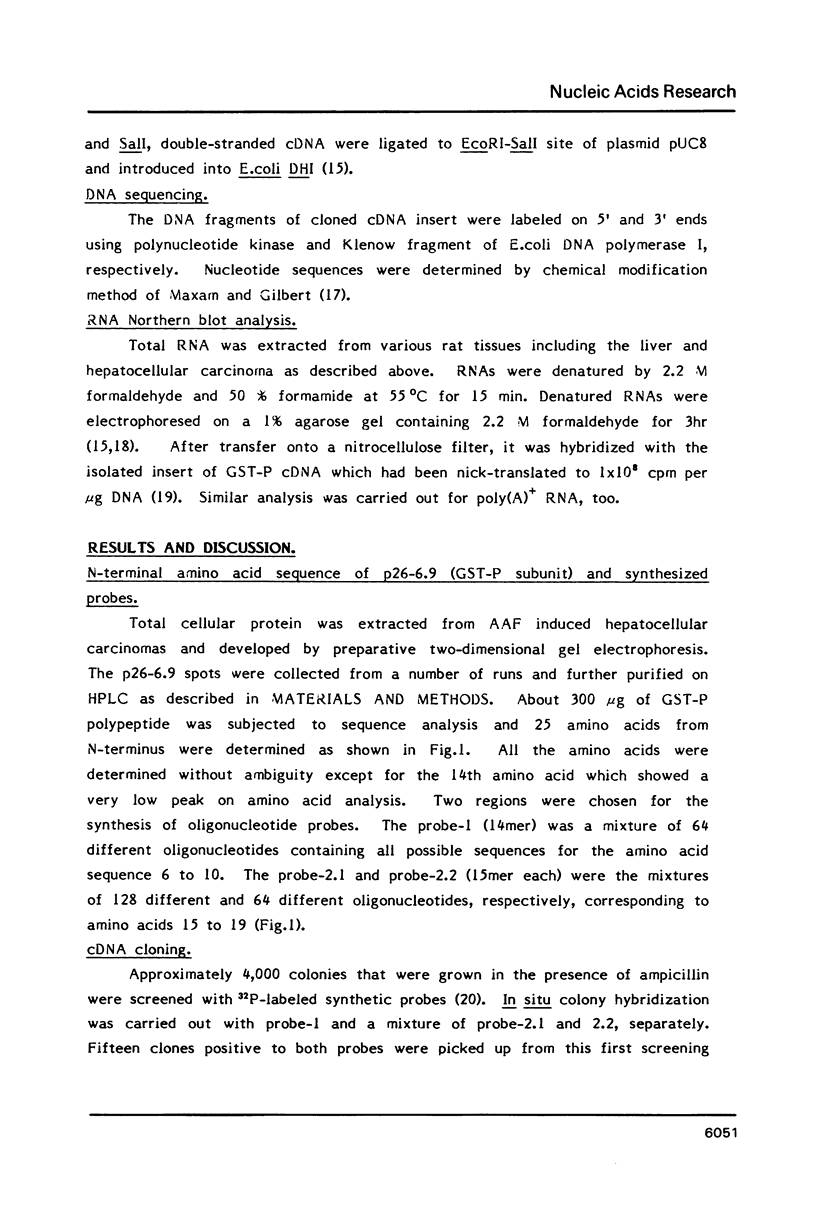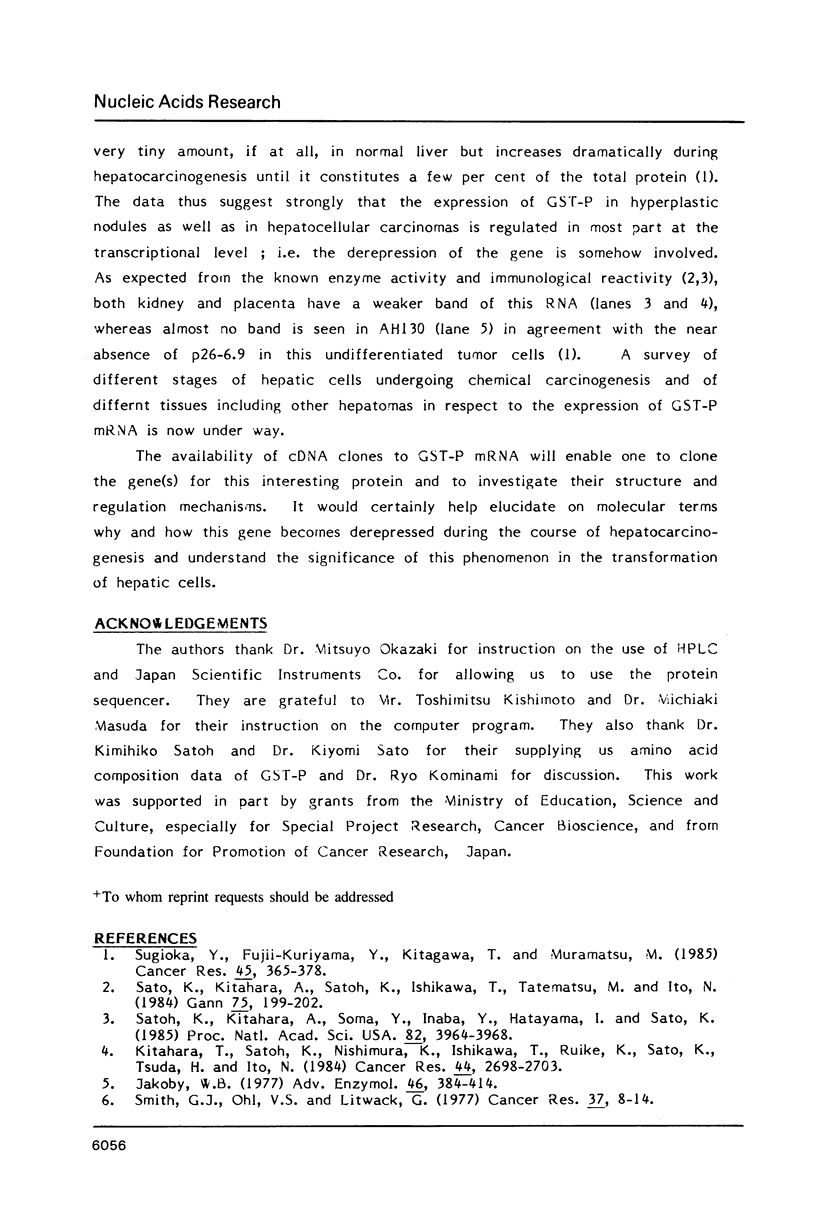Abstract
A cDNA library prepared from poly(A)+ RNA of 2-acetylaminofluorene (AAF) induced rat hepatocellular carcinoma was screened by synthetic DNA probes deduced from a partial amino acid sequence of glutathione S-transferase P subunit that had been isolated from the tumor by two-dimensional gel electrophoresis. One of the four clones analyzed contained an mRNA region encoding the total amino acid sequence of this enzyme subunit and the complete 3'-noncoding region. The nucleotide sequence indicates that this enzyme subunit has 209 amino acids (calculated Mr=23,307) distinct from other glutathione S-transferase subunits such as Ya and Yc. Comparison of the amino acid sequences between these proteins indicates that glutathione S-transferase P subunit gene has been evolved from the ancestral gene at an earlier stage than the separation of Ya and Yc and that there are at least three domains having a considerable homology with each other in these enzymes. The very large increase of this mRNA in chemically induced hepatocellular carcinoma suggests a characteristic derepression of this gene during hepatocarcinogenesis.
Full text
PDF








Images in this article
Selected References
These references are in PubMed. This may not be the complete list of references from this article.
- Chasseaud L. F. The role of glutathione and glutathione S-transferases in the metabolism of chemical carcinogens and other electrophilic agents. Adv Cancer Res. 1979;29:175–274. doi: 10.1016/s0065-230x(08)60848-9. [DOI] [PubMed] [Google Scholar]
- Farber E., Cameron R. The sequential analysis of cancer development. Adv Cancer Res. 1980;31:125–226. doi: 10.1016/s0065-230x(08)60658-2. [DOI] [PubMed] [Google Scholar]
- Farber E. The sequential analysis of liver cancer induction. Biochim Biophys Acta. 1980 May 6;605(2):149–166. doi: 10.1016/0304-419x(80)90002-5. [DOI] [PubMed] [Google Scholar]
- Glisin V., Crkvenjakov R., Byus C. Ribonucleic acid isolated by cesium chloride centrifugation. Biochemistry. 1974 Jun 4;13(12):2633–2637. doi: 10.1021/bi00709a025. [DOI] [PubMed] [Google Scholar]
- Hanahan D., Meselson M. Plasmid screening at high colony density. Gene. 1980 Jun;10(1):63–67. doi: 10.1016/0378-1119(80)90144-4. [DOI] [PubMed] [Google Scholar]
- Helfman D. M., Feramisco J. R., Fiddes J. C., Thomas G. P., Hughes S. H. Identification of clones that encode chicken tropomyosin by direct immunological screening of a cDNA expression library. Proc Natl Acad Sci U S A. 1983 Jan;80(1):31–35. doi: 10.1073/pnas.80.1.31. [DOI] [PMC free article] [PubMed] [Google Scholar]
- Jakoby W. B. The glutathione S-transferases: a group of multifunctional detoxification proteins. Adv Enzymol Relat Areas Mol Biol. 1978;46:383–414. doi: 10.1002/9780470122914.ch6. [DOI] [PubMed] [Google Scholar]
- Kalinyak J. E., Taylor J. M. Rat glutathione S-transferase. Cloning of double-stranded cDNA and induction of its mRNA. J Biol Chem. 1982 Jan 10;257(1):523–530. [PubMed] [Google Scholar]
- Kitahara A., Satoh K., Nishimura K., Ishikawa T., Ruike K., Sato K., Tsuda H., Ito N. Changes in molecular forms of rat hepatic glutathione S-transferase during chemical hepatocarcinogenesis. Cancer Res. 1984 Jun;44(6):2698–2703. [PubMed] [Google Scholar]
- Lai H. C., Li N., Weiss M. J., Reddy C. C., Tu C. P. The nucleotide sequence of a rat liver glutathione S-transferase subunit cDNA clone. J Biol Chem. 1984 May 10;259(9):5536–5542. [PubMed] [Google Scholar]
- Lehrach H., Diamond D., Wozney J. M., Boedtker H. RNA molecular weight determinations by gel electrophoresis under denaturing conditions, a critical reexamination. Biochemistry. 1977 Oct 18;16(21):4743–4751. doi: 10.1021/bi00640a033. [DOI] [PubMed] [Google Scholar]
- Maxam A. M., Gilbert W. A new method for sequencing DNA. Proc Natl Acad Sci U S A. 1977 Feb;74(2):560–564. doi: 10.1073/pnas.74.2.560. [DOI] [PMC free article] [PubMed] [Google Scholar]
- O'Farrell P. H. High resolution two-dimensional electrophoresis of proteins. J Biol Chem. 1975 May 25;250(10):4007–4021. [PMC free article] [PubMed] [Google Scholar]
- Pickett C. B., Telakowski-Hopkins C. A., Ding G. J., Argenbright L., Lu A. Y. Rat liver glutathione S-transferases. Complete nucleotide sequence of a glutathione S-transferase mRNA and the regulation of the Ya, Yb, and Yc mRNAs by 3-methylcholanthrene and phenobarbital. J Biol Chem. 1984 Apr 25;259(8):5182–5188. [PubMed] [Google Scholar]
- Pickett C. B., Telakowski-Hopkins C. A., Donohue A. M., Lu A. Y. Isolation and characterization of a DNA sequence complementary to rat liver glutathione S-transferase B mRNA. Arch Biochem Biophys. 1983 Feb 15;221(1):89–98. doi: 10.1016/0003-9861(83)90124-8. [DOI] [PubMed] [Google Scholar]
- Rigby P. W., Dieckmann M., Rhodes C., Berg P. Labeling deoxyribonucleic acid to high specific activity in vitro by nick translation with DNA polymerase I. J Mol Biol. 1977 Jun 15;113(1):237–251. doi: 10.1016/0022-2836(77)90052-3. [DOI] [PubMed] [Google Scholar]
- Sato K., Kitahara A., Satoh K., Ishikawa T., Tatematsu M., Ito N. The placental form of glutathione S-transferase as a new marker protein for preneoplasia in rat chemical hepatocarcinogenesis. Gan. 1984 Mar;75(3):199–202. [PubMed] [Google Scholar]
- Satoh K., Kitahara A., Soma Y., Inaba Y., Hatayama I., Sato K. Purification, induction, and distribution of placental glutathione transferase: a new marker enzyme for preneoplastic cells in the rat chemical hepatocarcinogenesis. Proc Natl Acad Sci U S A. 1985 Jun;82(12):3964–3968. doi: 10.1073/pnas.82.12.3964. [DOI] [PMC free article] [PubMed] [Google Scholar]
- Smith G. J., Ohl V. S., Litwack G. Ligandin, the glutathione S-transferases, and chemically induced hepatocarcinogenesis: a review. Cancer Res. 1977 Jan;37(1):8–14. [PubMed] [Google Scholar]
- Sugioka Y., Fujii-Kuriyama Y., Kitagawa T., Muramatsu M. Changes in polypeptide pattern of rat liver cells during chemical hepatocarcinogenesis. Cancer Res. 1985 Jan;45(1):365–378. [PubMed] [Google Scholar]
- Takami H., Busch H. Two-dimensional gel electrophoretic comparison of proteins of nuclear fractions of normal liver and Novikoff hepatoma. Cancer Res. 1979 Feb;39(2 Pt 1):507–518. [PubMed] [Google Scholar]
- Tu C. P., Lai H. C., Li N. Q., Weiss M. J., Reddy C. C. The Yc and Ya subunits of rat liver glutathione S-transferases are the products of separate genes. J Biol Chem. 1984 Aug 10;259(15):9434–9439. [PubMed] [Google Scholar]
- Tu C. P., Weiss M. J., Karakawa W. W., Reddy C. C. Cloning and sequence analysis of a cDNA plasmid for one of the rat liver glutathione S-transferase subunits. Nucleic Acids Res. 1982 Sep 25;10(18):5407–5419. doi: 10.1093/nar/10.18.5407. [DOI] [PMC free article] [PubMed] [Google Scholar]
- Yokosawa N., Taniguchi N., Tsukada Y., Makita A. Physiochemical and immunochemical characterization of gamma-glutamyl transpeptidase from yolk sak tumor and ascitic hepatoma (AH-66) cells. Oncodev Biol Med. 1981;2(3):165–177. [PubMed] [Google Scholar]



